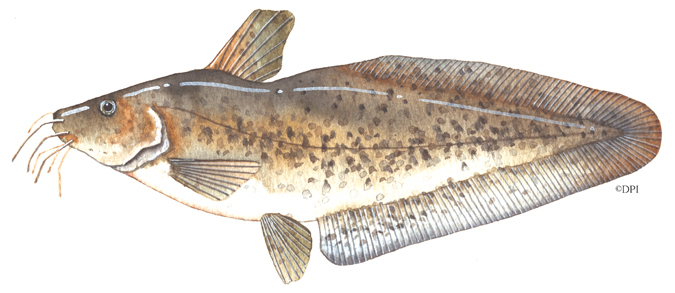Freshwater catfish

| Common Name: | Freshwater catfish |
| Other Name/s: | eel-tailed catfish, tandan catfish |
| Family: | Plotosidae |
| Scientific Name: | Tandanus tandanus (Mitchell, 1838) |
| Origin: | Native |
Conservation Status
State: Classified as "endangered" under the Flora and Fauna Guarantee Act 1988.
Description
Elongate eel-like body with the tail tapering to a point. No scales and no adipose fin. Large head, flattened underneath, with moderate-sized eyes. Low mouth with thick, fleshy lips. Four pairs of whiskery barbels around the mouth. Tough, smooth skin. Dorsal and pectoral fins both have strong saw-edged spines. Colour varies with size; small fish to 15 cm are grey or brown on the back and the sides are often mottled with dark brown to black blotches; a white or yellowish belly. Larger fish lack the mottling and vary from olive-green to brown, black or purplish on the back and upper sides with a white belly.
Distribution
Murray River tributaries and the Murray River up to Echuca. Introduced into the Wimmera River at Horsham and Victoria Lake, Maryborough. Recently reported in the Yarra River in the Eltham area. Common in some areas, but not as abundant as in the past.
Habitat
Variety of habitats, including lakes, rivers, creeks and billabongs, usually in sluggish or still water. Inhabits and spawns in flowing streams.
Freshwater catfish prefer areas of sluggish or still water out of the current of the main channel. They are found in weedy areas on mud substrate and live and feed on the substrate.
The adults are usually solitary fish whereas juveniles form loose schools. They appear to be sedentary fish with very limited movement along the river. They are most active at night.
Brief Biology
Recorded to 90 cm in length and 6.8 kg in weight, individuals above 2 kg are uncommon. Essentially carnivorous bottom feeders, capable of exploiting a wide range of food sources. Crustaceans are the most important dietary item, followed by insects, snails and small fish. Water temperature between 20 and 24°C is considered the primary stimulus for spawning. Spawning involves construction of nests in sand or gravel by the male fish.
If the nest is exposed by a drop in water level, another nest is built. If several nests are built and abandoned because of fluctuating water, spawning will not occur. Females deposit eggs, leaving the male to fan, clean and guard the nest for up to 2 weeks, although eggs usually hatch within 7 days. Nests have been observed to be used for several consecutive years, whether by the same or different pairs of fish is not known.
Other Notes
The Wimmera River and its tributaries are the only waters in Victoria where freshwater catfish can be legally caught. They were introduced into the Wimmera River downstream of Horsham in the 1970's by the Wimmera Angling Association and are now abundant and widespread down to Jeparit.
They have established substantial enough populations to be exempted from the protection given to all other Victorian populations of freshwater catfish under the Flora and Fauna Guarantee Act 1988.
Fish should be handled carefully, as the saw-edged spines in the dorsal and pectoral fins can inflict painful wounds. Mature fish apparently have very limited range of movement, usually less than 5 km, and local populations could be greatly affected by heavy fishing, pollution or destruction of habitat and spawning areas. Adult specimens have long been recognized as having good table qualities.
Regulations
Recreational Fishing Licence requirements, and the regulations affecting the taking of freshwater catfish in Victoria, are provided in the Victorian Recreational Fishing Guide, available free from RFL sales agents.
Further Reading
- A Guide to the Freshwater Fish of Victoria, Phillip Cadwallader & Gary Backhouse, Department of Conservation and Environment.
- Australian Freshwater Fishes, John R. Merrick & Gunther E. Schmida.
- Biological Information for Management of Native Freshwater Fish in Victoria, J D Koehn, W G O'Connor.

